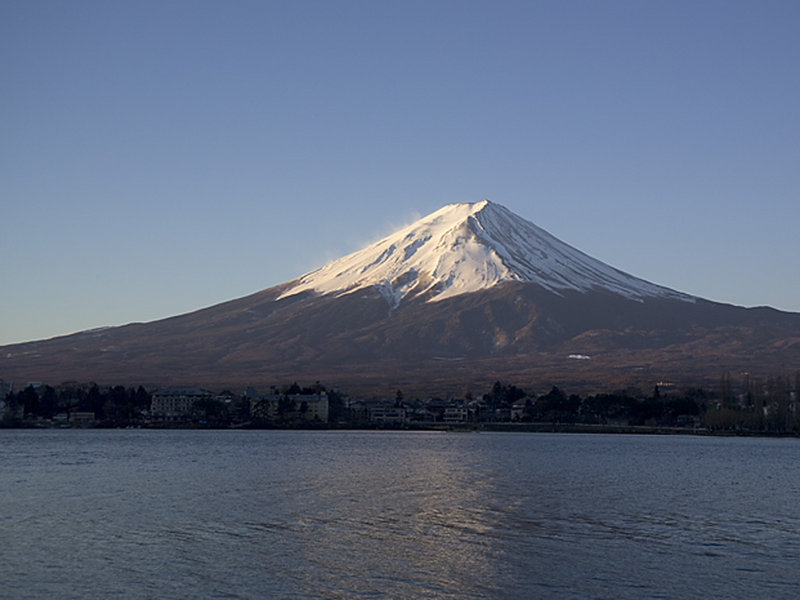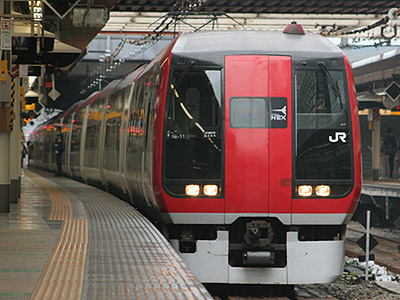Kanagawa Prefecture, Japan
(20 December 2009)
Some points on the geography and history of Kanagawa
The Kanagawa prefecture is located in the south-eastern part of Japan (see detailed map), wedged between Tokyo to the north, the Sagami Bay
to the south, Mount Fuji to the northwest and Tokyo Bay to the east. For
administrative purposes, Kanagawa is considered part of the Greater Tokyo Area consisting of the prefectures of Chiba,
Kanagawa, Saitama and Tokyo.
Kanagawa has a rich history dating back to the Jomon period (around 400 BC), Yamato period (around 5th century AD),
Kamakura period (1185-1332) and Tokugawa shogunate period (1683-1868). Kamakura in Kanagawa
was the capital of Japan during the Kamakura period.
About 3000 years ago, Mount Hakone on the far west of the prefecture erupted resulting in the formation of the crater lake Ashi, which is now known for
its numerous hot springs and scenic spots to get splendid views of Mt.Fuji.
Kanagawa is also associated with the Kanagawa Joyaku or the Kanagawa Convention of 1854 signed between Commondore Matthew Perry and the Tokugawa shogunate to
force open Japanese ports for trade with the United States. In 1859, Yokohama, the capital of Kanagawa, therefore became the first
Japanese port to be opened to foreign traders. In 2009, Yokohama commemorated
150 years of opening of its port.
In 1923, the Great Kanto earthquake (magnitude of 8.3 on the Ritcher scale) with its epicenter under the Sagami Bay devastated Yokohama, Tokyo
and the surrounding prefectures of Chiba and Shizouka. Yokohama and
Kawasaki were also heavily damaged by US bombings during the Second World War in 1945.
Kanawaga, especially Yokohama, underwent rapid urbanization and reconstruction after the War. Kanagawa is now the
most populous prefecture in Japan. In 1993, the Yokohama Landmark Tower (at the Minato Mirai area) became the tallest
building in Japan. In 2002, the FIFA World Cup was held at the International Stadium in Yokohama.
Kanagawa is also associated in the art world with Kanagawa Oki Nami Ura (lit. 'Under a Wave of Kanagawa'), a famous
woodblock painting by the Japanese artist Hokusai, painted around 1832 (see more details).
It depicts the enormous waves threatening the boats
off the coast of Kanagawa. The painting also shows Mt. Fuji in the background. Copies of this painting are at the Metropolitan
Museum of Art in New York City and the British Museum in London.
 Mount Fuji: Even though Mount Fuji is located outside the Kanagawa prefecture, it deserves a brief mention here
because it forms a distinctive feature of the geography of Japan and is also easily accessible from Yokohama. It is about
3776 metres (12,388 feet) high and is the highest peak in Japan. Along with Mount Tate and Mount Haku, it is one of the
'three holy mountains' of Japan. Mount Fuji is a well-known symbol of Japan and is frequently depicted in Japanese arts
and photographs. It is surrounded by several lakes, the most popular being Kawaguchi-ko (Lake Kawaguchi). There
are direct buses (two and half hour drive) to this lake from Yokohama. Kawaguchi-ko very popular among tourists and is known
for providing excellent views of Mt. Fuji. It also forms a hub for those wishing to climb Mt. Fuji.
Mount Fuji: Even though Mount Fuji is located outside the Kanagawa prefecture, it deserves a brief mention here
because it forms a distinctive feature of the geography of Japan and is also easily accessible from Yokohama. It is about
3776 metres (12,388 feet) high and is the highest peak in Japan. Along with Mount Tate and Mount Haku, it is one of the
'three holy mountains' of Japan. Mount Fuji is a well-known symbol of Japan and is frequently depicted in Japanese arts
and photographs. It is surrounded by several lakes, the most popular being Kawaguchi-ko (Lake Kawaguchi). There
are direct buses (two and half hour drive) to this lake from Yokohama. Kawaguchi-ko very popular among tourists and is known
for providing excellent views of Mt. Fuji. It also forms a hub for those wishing to climb Mt. Fuji.
Useful information and some travel tips
Currency: Japanese Yen (1USD is approx. 89JPY; 1SGD is approx. 64JPY)
Language: Japanese (very few people can understand and speak English)
Population: Around 8.9 million, out of which about 3.6 million live in the capital city Yokohama.
Reaching and traveling within Yokohama:
International travellers can fly into Tokyo Narita and then take the Narita Express (NEX) to Yokohama. Foreigners (non-Japanese passport holders)
can avail a NEX + Suica offer: for JPY 3500, one can get an one-way ticket from Tokyo Narita to Yokohama + a Suica card (pre-paid
travel card) with an initial top-up of JPY 1500. This is an amazing offer considering that travelling is very expensive within Japan
(an ordinary one-way ticket from Narita to Yokohama on the NEX costs JPY 4180).

Japan has a wide and efficient railway network. The Japan Rail (JR) network connects all important cities and towns within Japan,
while there are local subway lines within cities and suburbs. Foreign travellers can easily get lost in the subway network of Tokyo.
However, Yokohama has a more easily comprehendable subway network,
if you have some prior experience of traveling by the London Underground or Singapore MRT.
By the NEX, one can drop off at the Yokohama station and then change to the appropriate subway line.
Yokohama also has an extensive bus network.
The Narita airport terminals and most railway stations in Yokohama are well-directed and have important sign boards in Japanese as well as English.
The important announcements within the stations and trains are also made in both Japanese as well as English. However, very few people can understand
and speak English, but are usually willing to help if you ask for directions. The best way to ask for directions or
travel information is to keep printouts of maps and places in Japanese and to show these while asking for directions.
Except the main streets, no streets in Japan are named. Therefore, most directions are given based on small landmarks; for example,
"Go straight, turn right at the signal and walk towards Lawson". Traveling within Japan is usually safe and most places
are usually patrolled by the police. There are easily-accessible tourist information centers at all major railway stations.
Keeping a mobile phone while traveling within Japan is usually helpful.
Japan has only CDMA and 3.5G mobile networks. Therefore, GSM mobile phones do not work in Japan. Also, not many international networks provide
roaming service within Japan. So, if you have a 3.5G handset which you wish to use within Japan, make sure that your service
provider has a tie-up with one of the providers within Japan. One can also rent a mobile phone with SIM at the Narita airport.
SoftBank Global and other local providers have
outlets at the Narita airport for phone rentals.
You can book a mobile phone online and pickup it up at one of the outlets upon arriving at Narita, and return it back while departing.
Promotions:
The Japanese National Tourism Organization (JNTO) has started the new Visit Japan campaign
to promote tourism. If you are visiting Japan then just browse through the campaign pages and look-out for interesting offers
and promotions.
Photographs
I traveled to Kanagawa between 12-Dec-2009 and 19-Dec-2009. I am sharing some photographs taken during this visit with a hope to give
a first-hand account of the whole experience.
Yokohama
Kamakura
Kawaguchiko and Mt. Fuji
Comments from viewers
Useful links
Here are some useful travel guides and links on Kanagawa (Yokohama):
Japan travel guide
Lonely Planet on Yokohama
Visit Japan
© Sriganesh
 Mount Fuji: Even though Mount Fuji is located outside the Kanagawa prefecture, it deserves a brief mention here
because it forms a distinctive feature of the geography of Japan and is also easily accessible from Yokohama. It is about
3776 metres (12,388 feet) high and is the highest peak in Japan. Along with Mount Tate and Mount Haku, it is one of the
'three holy mountains' of Japan. Mount Fuji is a well-known symbol of Japan and is frequently depicted in Japanese arts
and photographs. It is surrounded by several lakes, the most popular being Kawaguchi-ko (Lake Kawaguchi). There
are direct buses (two and half hour drive) to this lake from Yokohama. Kawaguchi-ko very popular among tourists and is known
for providing excellent views of Mt. Fuji. It also forms a hub for those wishing to climb Mt. Fuji.
Mount Fuji: Even though Mount Fuji is located outside the Kanagawa prefecture, it deserves a brief mention here
because it forms a distinctive feature of the geography of Japan and is also easily accessible from Yokohama. It is about
3776 metres (12,388 feet) high and is the highest peak in Japan. Along with Mount Tate and Mount Haku, it is one of the
'three holy mountains' of Japan. Mount Fuji is a well-known symbol of Japan and is frequently depicted in Japanese arts
and photographs. It is surrounded by several lakes, the most popular being Kawaguchi-ko (Lake Kawaguchi). There
are direct buses (two and half hour drive) to this lake from Yokohama. Kawaguchi-ko very popular among tourists and is known
for providing excellent views of Mt. Fuji. It also forms a hub for those wishing to climb Mt. Fuji.
